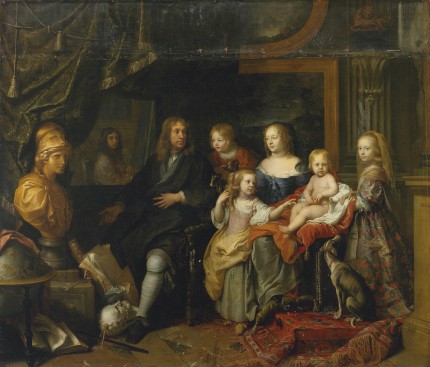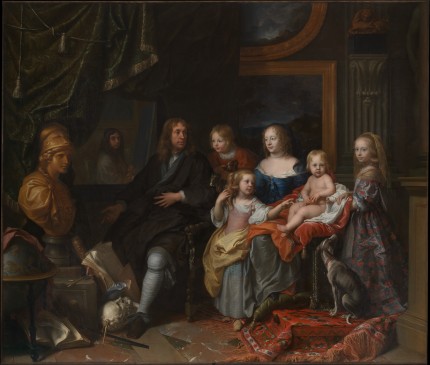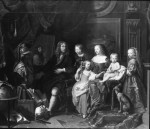Charles Le Brun’s monumental portrait Everhard Jabach and His Family purchased last year by the Metropolitan Museum of Art has been restored and is now on display in the museum’s European Paintings Gallery alongside other French works from the 17th century. Feast your eyes upon this pair of very satisfying before and after pictures:


The painting is 7.6 feet by 10.6 feet, so even getting it the Met from London was a task as monumental as the portrait. It couldn’t be padded to the gills because if the crate got too big it wouldn’t fit on the cargo plane. Thankfully there was no damage in transit.
 Once it arrived safely, conservator Michael Gallagher’s first task was to remove the varnish applied in the late 19th or early 20th century. It was discolored and darkened, giving the painting a yellowed tint. Using cotton swabs and a solvent custom blended to remove this particular varnish without damaging the paint underneath, Gallagher painstakingly cleaned the whole surface revealing Le Brun’s rich hues and previously invisible details like baby Heinrich’s adorable pink toes. That delicate pink and white skin is even more evident in figure of Jabach’s daughter Anna Maria whose skin, hair and clothes look completely different with the varnish gone.
Once it arrived safely, conservator Michael Gallagher’s first task was to remove the varnish applied in the late 19th or early 20th century. It was discolored and darkened, giving the painting a yellowed tint. Using cotton swabs and a solvent custom blended to remove this particular varnish without damaging the paint underneath, Gallagher painstakingly cleaned the whole surface revealing Le Brun’s rich hues and previously invisible details like baby Heinrich’s adorable pink toes. That delicate pink and white skin is even more evident in figure of Jabach’s daughter Anna Maria whose skin, hair and clothes look completely different with the varnish gone.
 That was child’s play compared to the work Gallagher and his team had to do to repair damage to the top of the painting. That big horizontal line you see running across the width 18 inches below the top is a fold mark. It’s not clear when the canvas was folded over, but there’s a picture published in an 1969 issue of Country Life of the painting hanging in Olantigh Towers, the Kent stately home where it lived from 1832 until the 2014 sale, that shows the painting folded. Olantigh Towers burned in 1903 and was rebuilt on a far more modest scale. It’s possible the monumental painting was reducing by folding so it would fit in the smaller space of the new home.
That was child’s play compared to the work Gallagher and his team had to do to repair damage to the top of the painting. That big horizontal line you see running across the width 18 inches below the top is a fold mark. It’s not clear when the canvas was folded over, but there’s a picture published in an 1969 issue of Country Life of the painting hanging in Olantigh Towers, the Kent stately home where it lived from 1832 until the 2014 sale, that shows the painting folded. Olantigh Towers burned in 1903 and was rebuilt on a far more modest scale. It’s possible the monumental painting was reducing by folding so it would fit in the smaller space of the new home.
It was a drastic, some might call it insane, choice. The top foot and a half of the canvas was folded over a smaller stretcher and hammered into place with tacks driven through the painted surface. It was finally liberated from its Procrustean prison in 2012 when the painting was flattened out and a temporary strip-lining attached around the perimeter with wax-resin adhesive. This was good enough to show prospective buyers, but it wasn’t conservation. It was up to the Met’s team had to address the fold and the tack holes.
First they had to flip the painting onto its face, remove the stretcher, strip-lining and wax residue. You can see the team in action in a series of videos posted in this blog entry by Michael Gallagher. Then they had to flatten out the fold and bring the surface in plane. Again Gallagher posted a series of short and sweet videos to demonstrate the process. Before they could deal the holes, they had to flip the painting right-side up and work from the surface. That was ingeniously done as well.
Tubes, man. Handy with a giant Picasso curtain; handy with a giant Le Brun canvas.
After reattaching the canvas to its stretcher, conservators added canvas insets and fills to areas of paint and canvas loss. A coating of fresh varnish was next to prepare the filled areas and other faded parts for retouching.
All that was left was putting it in the new frame, custom-made by Parisian framers who have been in business since the 1800s and shipped to New York in four sections. That turned out to be a fortunate coincidence because the painting is so huge it was barely able to squeeze through the gallery doors naked. The elaborate gilded frame was assembled and installed in the gallery where the painting now hangs in all its restored glory.
Wonderful. The photo on the museum’s blog site of the painting being hung is marvelous- so lively and the painting just glows in the light and amidst the activity. I read through most of the posts about the conservation process and found it fascinating. If there is such a thing as methodical passion, this is an example.
Methodical passion is a great way of describing it. That’s just what you need to be able to clean 80-odd feet of surface area with nothing but a Q-tip. Wasn’t that a great blog? I really appreciated the posts about the frame, too, because framing is one of my secret obsessions.
Man, those people in the 1600s were pretty messy! Look how cluttered up that room in the painting is 😀
Who doesn’t have a few globes and statue heads lying around? 😉
“I was guided to Jabachs domicile […]. That family might have passed away long ago, but everything was still at its place. We saw […] a massive fireplace […] and over that fireplace there was a very large painting of the family: The former rich owner of this domicile depicted seating next to his wife, surrounded by their offspring – All alert, fresh and lively, as if pictured yesterday or today even, and yet they had all passed away.”
Autobiography by Johann Wolfgang von Goethe, ‘Aus meinem Leben: Dichtung und Wahrheit / From my Life: Poetry and Truth’, Book 14, where he speaks of a visit to Cologne in 1774. The picture was apparently taken in either Cologne or Paris.
Excellent quote! Yes, the portrait was in the family home in Cologne until 1792 when it was sold by one of Jabach’s descendants and transported to England. It was a very famous painting in its time. Joshua Reynolds also made a point of going to see it when he was in Cologne.
This space on the web is one of my favorite places to visit each day.
Thanks so much for sharing what you find and for providing such clear and lucid explanations.
You write about so many different subjects and do it well each time.
Beautiful work.
Both the painting and the conservation effort!
That’s such a weird place to crop the painting too, if you were going to do such a thing. My guess is it was chosen for the size that resulted and with little or no regard to the aesthetics of the portion remaining on view.
I suppose we’re lucky the top portion wasn’t simply cut away!
As for how to relocate delicate historic paintings, maybe in the future it can be accomplished via the internet. I hear it’s really just a series of tubes.
The colors and the quality of the work are certainly much more apparent with the varnish removed, but I think that there was an error in photography of the cleaned/repaired work. I can barely see most of the charming details anymore– such as the lion taking down the horse on that false column’s finial– without doing horrible things to my monitor’s saturation and contrast. Or did it really actually become so dark with the amber varnish removed? …no, it looks like they cranked the ISO way up for the “before” shot and then way down for the “after” shot… which is poor practice for an appropriate comparison of the stages of the work.
Favorite thing about this work: The careful attention to how draping and folding impacts the patterns of the fabric. It’s so… perfect! Many artists of every age seem to often be daunted by or lazy about that sort of thing. But this? Fabulous. No wonder it was so oft visited by important personages.
It’s a shame you don’t have a donate button! I’d certainly donate to this outstanding blog!
I suppose for now i’ll settle for book-marking and
adding your RSS feed to my Google account. I look forward to brand new updates and will share this blog with my Facebook group.
Talk soon!
Ich habe gelesen mehrere ausgezeichnete Sachen hier.
Definitiv Preis bookmarking Änderungsvorschlägen.